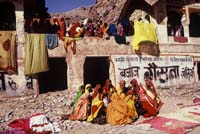
 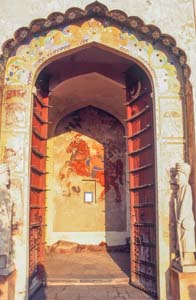 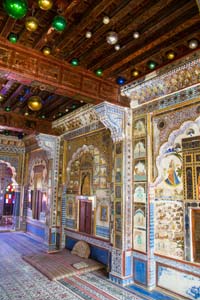 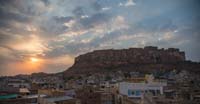 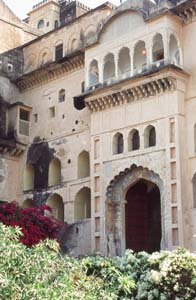  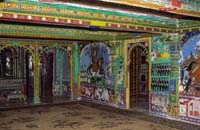   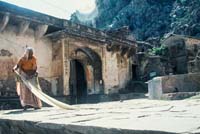 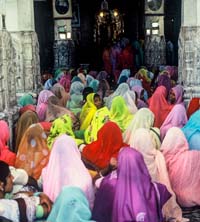   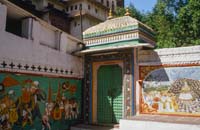  |
Best of Rajasthan 18 days from Delhi Day 1 – Fly to Jodhpur Day 2 – In Jodhpur This is the day to explore the massive Mehrangarh Fort, probably the most spectacular fortified citadel in India. Its massive and impregnable walls seem to grow out of the hill upon which it was built. From the outside, It is militaristic architecture at its most imposing, but at the top of the ramparts, it gives way to whimsical cupolas, chattris, archways, and domes. And once inside, opulence and sensuality reign. Find a guide who can escort you through rooms furnished with the antiques and fabulous Rajasthani art which was collected by the Maharajas. After you see the fort, you can walk around the alleys of the Sardar Bazaar which have sprung up around the clock tower in the center of town. Many different types of goods converge here, vegetable and fruits, spices, textiles, handicrafts, and mundane plastic kitchenware. Jodhpur is also one of my favorite shopping stops. There are plenty of “antique” stores out, just past the Umaid Bhawan hotel. Day 3 drive to via Luni or Rohet Garh It’s less than 2 hours to either Luni or Rohet Garh, both fantastic hotels, converted from smallish princely Rajput palaces. Check with your tour operator to see which one gets the best accolades at the moment (I loved both of them) This are was home to the desert Champavat Clan. And the Rajput spirit still runs strong. Day 4 – Drive to Udaipur via Khumbalgarh and Ranakpur. The drive from either of these places to Udaipur is about 5 hours, and is one of the nicest drives in Rajasthan. Small lakes, craggy hills and little farming villages are home to gentle people whose way of life has changed little in thousands of years. Irrigation is still done with the help of the Persian Wheel and bullocks still till the fields. Your first stop along the way is at Ranakpur, one of the five holy Jain sites. Some say this site, set in a verdant valley, is the most beautiful Jain temple complex in India. Based on the mandala, this temple is a classic example of ancient Indian sacred geometry. Made of white marble, the entire temple is so intricately carved that is boarders on fantasy. Layer within layer of sculpted animals, flowers, and protective deities cascade down the walls and over the ceilings. The main temple, dedicated to the Jain Tirthankara (“revealer of truth”), Adinath, has 80 domes and 1444 carved pillars, every one of which is different and unique. The immense city-fortress of Kumbhalgarh, stretching along a ridge eight miles long, is your next stop. Built in the 15th century, this fort is an outstanding example of the more austere Afghan architecture. Day 5 – In Udaipur This delightful and picturesque town is best explored on foot. There are scores of beautiful small temples, both in town and around the lake and most of the people delight in showing interested foreigners their puja ceremonies. The bazaar area is full of local handicrafts and this is one of the best places in Rajasthan to have instant clothes made. Udaipur is also famous as India’s center for miniature paintings and small shops all over town display beautiful examples of the various styles. There is a very famous ayurvedic center here, the Madan Mohan College, and visitors are welcome. Day 6 – In Udaipur For anyone particularly interested in forts, you could take an aprox 6 hour trip out to the legendary Chittor Fort, original home of the Mewar clan. Left wounded and partially destroyed by some of India’s most epic battles with the Moguls, this huge city-fortress, more than any other in Rajasthan, attests to the valor and heroism of the Rajputs. The Eklingji temples, about 20 km. north of Udaipur in the village of Kailashpuri, would also be possible side trip. This collection of 16th century temples are dedicated to Lord Shiva, and his elegant black marble four-faced stature is the focalpoint of the main sanctuary. Another possibility for this day is an excursion to the town of Nathdwara, home of the traditional religious cloth paintings known as “pichwais”. This vibrant style of devotional painting was developed by a sect of Krishna devotees who, with a little divine intervention, settled here in the 16th century. This evening, think about a sunset cruise around the lake, stopping at Jagmandir Island to see the palace there which has been restored. Day 7 – Drive to Dungapur Kind of in the middle of no where (but definitely worth the 2 hour drive), Dungapur is the site of the fabulous Juna Mahal. This small but amazing fortress sports some of the most beautifully done interior wall paintings to be seen in Rajasthan. This fortress is about as authentic as it gets for old Rajasthan. The Jodhpur and Udaipur palaces may be the most spectacular, but this one feels like home. Dungapur is also home to the Bhil tribes people who are renown stonemasons. Hotel – The Udai Bilas is owned by the same family that still owns the Juna Mahal and staying there gives you free access to the palace. It’s very nice and serene, so it’s a win-win situation. It is situated on the banks of a seasonal lake and, in season, is home to masses of birds. It’s classical in style with art-deco furnishings. Day 8 – In Dungapur A day to explore Dungapur and hang out with the local people. If you are pressed for time, this day can be eliminated. Everything you need to see in Dungapur can be done in the afternoon that you arrive. Day 9 – Drive to Devi Garh It’s another 2 ½ hours back to the Devi Garh hotel which is just past Udaipur. There, not much happening in the immediate vicinity of the hotel, but Udaipur is about 45 minutes away. This is a relaxing day in one of Rajasthan’s most gorgeous palace hotels. , Day 10 – Drive to Deogarh Day 11 – Drive to Pushkar Day 12 – Day in Pushkar Day 13 – Drive to Phool Mahal hotel in Kishangarh Day 14 – Drive to Jaipur It’s about a 2 hour drive to Jaipur Day 15 – Day in Jaipur Set out this morning for the for the Amber Palace, the first capital of the Kuchwaha clan of Rajputs who began building in this area in about 1040 AD. The Amber Fort was begun in about 1600 and then abandoned in 1727 when Jai Singh moved the capital to Jaipur. Access to the fort is by traditional Maharaja style transport, sitting atop brightly painted and caparisoned elephants who lumber up the massive ramparts and through the enormous gates. This fort is very “touristy”, but fortunately many of the tourists that you meet are Indian who afford us a wonderful opportunity to see history through their eyes. The Hawa Mahal, the “Palace of the Winds”, is one of India’s most notable and most photographed sights. From the street, it looks like just another beautiful palace, but from the side, we find that it is just a facade where the women of the harem could sit to watch the life go by on the street. Make a short stop at the City Palace to see the four very famous painted doorways leading out to the main courtyard. Day 16 – To Samode The delightful walled village of Samode is medieval India at its best. Set away from the main road, it is totally untouched by the hullabaloo (did you know this is an Indian word?) that characterizes most Indian towns. Old stone houses, an ancient deserted hilltop fort and huge trees make this one of the most peaceful and enchanting settings in Rajasthan. Samode also carries some kind of magical photographic charm. Many India travelers report that their best pictures come form this little place. Take the afternoon to explore the town on our own or just relax around our amazing hotel. This is a great place for a short and atmospheric camel ride which can be booked at the hotel Hotel – Samode Palace Hotel quite majestic and could be very well be one of the highlights of your trip. The regular rooms are nice enough, but the suites are magical. Day 17 – To Neemrana It’s about a 3 hour drive to the Neemrana Fort Hotel. Day 18 – To Delhi |
